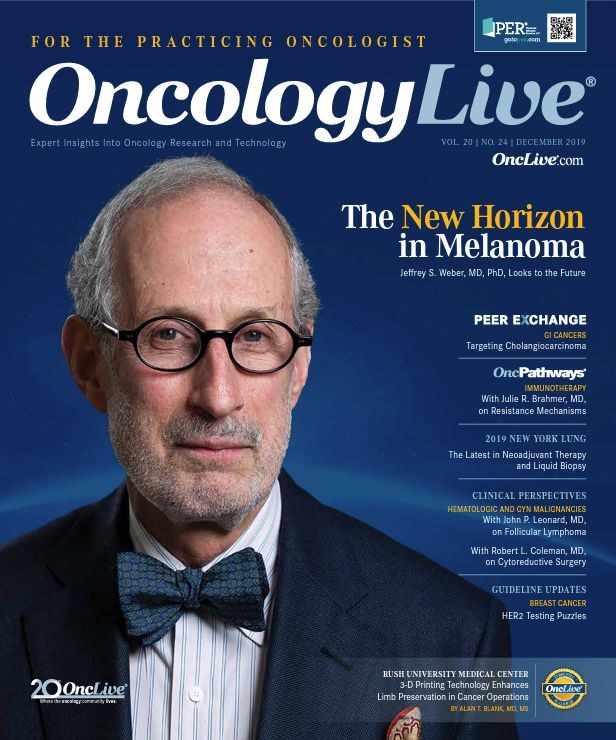Publication
Article
Oncology Live®
Guidelines Address Questions About Evaluating Less Common HER2 Testing Patterns
Author(s):
For the past 2 decades, clinical guidelines for the diagnosis and management of breast cancer have sought to clarify the definition of HER2 status, but several key questions remain.
Kalliopi Siziopikou, MD, PhD

Kalliopi Siziopikou, MD, PhD
For the past 2 decades, clinical guidelines for the diagnosis and management of breast cancer have sought to clarify the definition of HER2 status, but several key questions remain, Kalliopi Siziopikou, MD, PhD, said in a presentation at the 2019 Lynn Sage Breast Cancer Symposium.1
Published in the Journal of Clinical Oncology in 2018, the most recent HER2 guideline from the American Society of Clinical Oncology/College of American Pathologists (ASCO/CAP) addressed one area of uncertainty: less common HER2 result patterns.2 The update reclassified these cases to either HER2-negative or -positive groupings.
Siziopikou, director of breast pathology at Northwestern University’s Robert H. Lurie Comprehensive Cancer Center in Chicago, Illinois, reminded colleagues that HER2-targeted therapy significantly improves outcomes for patients with HER2-positive breast carcinomas in adjuvant, neoadjuvant, and metastatic settings and that HER2 gene amplification/protein overexpression occurs in 15% to 20% of invasive breast cancers, not the 25% to 30% initially reported.
Pathology labs use immunohistochemistry (IHC) to test for HER2 overexpression or in situ hybridization (ISH) to detect HER2 gene amplification. “One advantage to IHC and ISH is that the signals are interpreted in the context of the histopathology on tissue sections, permitting specific scoring in morphologically confirmed invasive cancer cells,” Siziopikou said. “Additionally, standard FFPE [formalin-fixed, paraffin- embedded] tissues are acceptable specimens, easily obtainable in most laboratory settings.”
Siziopikou emphasized that the focus of the 2007 ASCO/CAP guidelines was to limit false positives. By the time the first major ASCO/CAP guideline revision was released in 2013, some laboratories adopted the use of alternative chromosome 17 probe testing for equivocal fluorescence in situ hybridization (FISH) results, Siziopikou noted.
In contrast, the 2018 guidelines offered “guidance for less common FISH patterns, groups 2 to 4, which together constitute 5% of all cases,” Siziopikou said.
The new guidelines also addressed 5 common clinical questions and further clarified previous recommendations, Siziopikou said (Figure).
Clinical Cases
Clinical question 1 addressed in the guidelines addressed the issue of an appropriate definition for the IHC “equivocal” category (IHC 2+): “Revised definition of IHC 2+ (equivocal) is ‘invasive breast cancer with weak to moderate complete membrane staining observed in >10% of tumor cells.’”
Click to Enlarge

Siziopikou explained that IHC HER2-negative cases are generally accurate and do not need repeating on excisions. She noted several possible exceptions, such as the possibility of repeating IHC when the tumor is histologic grade 3, a small amount of high-grade tissue is present on the core, or the resection contains a high-grade component not present on the core. Conversely, the guidelines instruct not to repeat IHC when the tumor is histologic grade 1; infiltrating ductal or lobular carcinoma is strongly estrogen receptor/progesterone receptor positive; or tubular, mucinous, or cribriform carcinoma is >90% pure.
Clinical questions 3 to 5 all elicited the same answer: “[A] definitive diagnosis will be rendered based on additional [work-up].” Clinical question 3 asked whether invasive cancers with a HER2 enumeration probe 17 (CEP17) ratio of ≥2 should be considered ISH positive, especially given that the average HER2 signals per cell is <4.
Additionally, if the IHC result is not 3+ positive, it is recommended that the specimen be considered HER2 negative because of the low HER2 copy number by ISH and the lack of protein overexpression.
Clinical question 4 asked whether invasive cancers with an average of ≥6 HER2 signals per cell with a HER2/CEP17 ratio of <2 should be considered ISH positive.
Siziopikou said, “When concurrent IHC results are negative (0 or 1+), it is recommended that the specimen be considered HER2 negative.”
Clinical question 5 probed the diagnosis for cases with an average HER2 signals per tumor cell of ≥4 and <6 and the HER2/ CEP17 ratio of <2, formerly diagnosed as ISH equivocal for HER2. The guidelines committee offered this clarification: “When IHC results are not 3+ positive, it is recommended that the sample be considered HER2 negative without additional testing on the same specimen.”
The 2018 guideline considered whether alternative ISH probe testing should be used to assign HER2 status. “Clinical information about benefit from HER2- targeted therapy in [high-CEP17] patients is not available because these patients would not have been eligible for the original pivotal trials,” Siziopikou said.
“Additionally, many of the alternative probes are not analytically or clinically validated, so the 2018 Expert Panel strongly recommends against alternate probe testing as a routine testing strategy. A clinicopathological correlation and/or a second opinion are more helpful,” Siziopikou added.
Clinical question 2 asked whether HER2 testing of a surgical specimen must be repeated if the initial core biopsy was negative. The answer, according to the guidelines is, “If the initial HER2 test result in a core needle biopsy specimen of a primary breast cancer is negative, a new HER2 test may be ordered on the excision specimen.”








